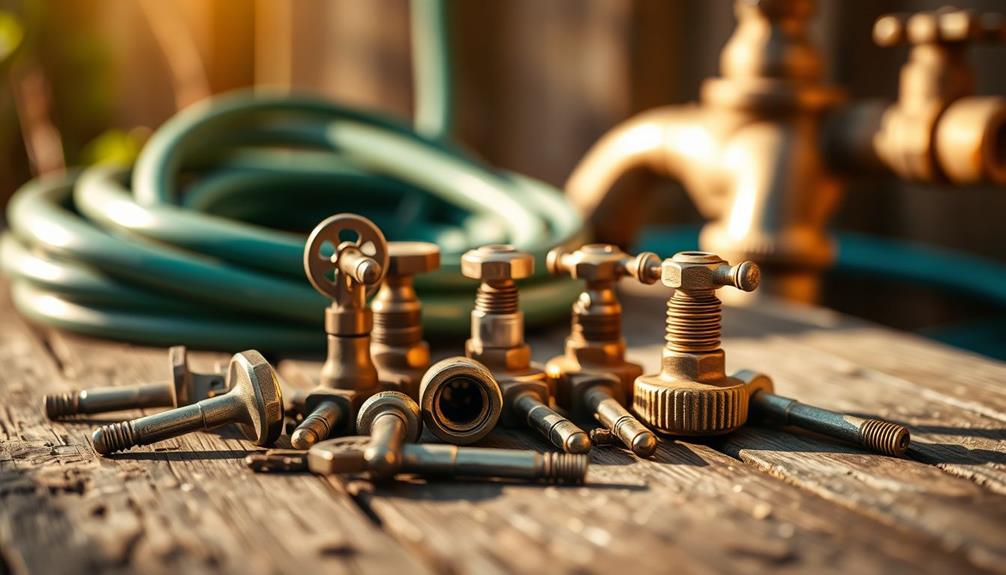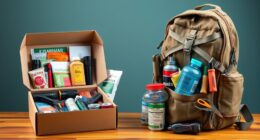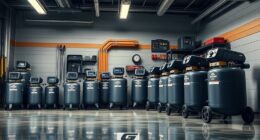Signal mirrors are essential for survival success, as they attract attention quickly during emergencies. You'll want a lightweight, durable mirror for easy packing, and options like acrylic or glass provide different benefits. Acrylic mirrors are shatter-resistant and portable, while glass mirrors can signal over 50 miles. Focus on reflectivity and ease of use to maximize effectiveness. Practice techniques like the V Finger Method for accurate alignment. Keeping your mirror clean and well-maintained boosts its performance. They're just one piece of your survival toolkit, and there's more to explore about optimizing your signal strategies and preparation methods.
Key Takeaways
- Choose lightweight and durable signal mirrors, like acrylic or EDC options, for portability in survival kits.
- Opt for high-reflectivity glass mirrors to maximize signaling distance, capable of reaching up to 50 miles.
- Regularly practice effective signaling techniques, such as the V Finger Method, to improve accuracy and response time.
- Maintain your mirror by cleaning it regularly and storing it in a protective case to ensure optimal performance.
- Educate yourself and others on the importance of signal mirrors and practice their use in various environments.
Importance of Signal Mirrors

When you're out in the wilderness or facing an emergency, having a signal mirror can be a lifesaver.
These tools are designed to attract attention, helping rescuers locate you quickly. Their high reflective capability means they can send signals over great distances, even in various weather conditions.
Lightweight and portable, you can easily pack a signal mirror in your survival kit or backpack. In outdoor and military operations, their durability guarantees they'll withstand harsh environments, making them reliable when you need them most.
By utilizing a signal mirror, you boost your chances of rescue considerably.
Types of Signal Mirrors

There are several types of signal mirrors, each designed to meet specific needs and preferences. For instance, lightweight acrylic mirrors are effective and durable, making them a popular choice.
If you're looking for something compact, consider an EDC signal mirror like the UST StarFlash Micro, which is tough and portable.
For long-range signaling, upgrade to glass mirrors that can reflect light up to 50 miles, such as the MIL-M-18371E.
Plastic mirrors are shatterproof and lightweight, while emergency signal mirrors are specifically crafted for survival situations.
You might also explore multi-functional mirrors that include a compass or magnifying features.
Selecting the right type guarantees you're prepared for any situation while maximizing your signaling effectiveness.
Key Features to Evaluate

Evaluating the key features of signal mirrors is essential for ensuring you choose the right tool for your needs.
First, consider the construction—glass mirrors offer superior reflectivity, while acrylic mirrors are lighter but can scratch easily.
Next, think about size; larger mirrors can send signals farther but may be bulkier. Weight matters too; lightweight options are best for hiking or backpacking.
Reflectivity is vital as higher reflectivity enhances signaling effectiveness. Also, durability is key—materials must withstand harsh conditions.
Finally, look for ease of use; a simple design with retroreflective sighting grids can greatly improve accuracy in emergencies.
Effective Signaling Techniques

Mastering effective signaling techniques is just as important as choosing the right signal mirror. You should aim the mirror at a specific target, like a person or aircraft, to create a focused flash.
Use methods like the V Finger Method, where you form a "V" with your fingers to help you align the mirror accurately. Consider using short flashes to convey urgency, as patterns can attract attention more efficiently than constant light.
Regularly practice in various environments to refine your skills and guarantee you're prepared for real-life situations. Remember to keep your mirror clean for ideal reflectivity, as dirt or smudges can hinder your signaling efforts considerably.
With practice, you'll enhance your chances of being noticed and rescued.
Practical Applications in Survival

Signal mirrors play an essential role in survival situations, particularly when you're lost or in distress. They can help you attract attention from rescuers, especially in remote areas. By mastering the techniques for using them effectively, you can greatly increase your chances of being seen.
Here's a quick reference table for practical applications of signal mirrors:
| Situation | Application |
|---|---|
| Lost in Wilderness | Signal for help using sun reflection |
| Stranded at Sea | Flash signals to passing boats |
| Emergency in Mountains | Use in conjunction with other signals |
| Nighttime Signaling | Reflect light from a fire or flashlight |
In every scenario, remember to keep your mirror clean for ideal performance. Your ability to signal can make all the difference in a survival situation.
Preparation and Training Resources

Keeping a signal mirror in your survival kit is just the beginning; preparation and training are essential for effective use in emergencies. Getting familiar with the proper techniques for signaling with a signal mirror, such as angling it to reflect sunlight towards potential rescuers, is crucial. Additionally, having a backup plan for signaling is important, which is why it’s recommended to include emergency flares for signals in your survival kit. By having multiple means of signaling for help, you can increase your chances of being spotted and rescued in a critical situation.
Start by familiarizing yourself with different signaling techniques, like the V Finger Method and Fireball Method. Practice these methods regularly to boost your confidence and improve your accuracy.
Join local survival courses or workshops to learn from experienced instructors, and don't hesitate to educate friends and family about the importance of signal mirrors.
Additionally, review local survival resources and strategies to prepare for unexpected challenges. The more you prepare and practice, the better equipped you'll be to use your signal mirror effectively when it matters most.
Maintenance and Care Tips

After you've chosen the right signal mirror for your needs, proper maintenance is essential to guarantee its effectiveness in emergencies.
Start by regularly cleaning the reflective surface with a soft, lint-free cloth to remove dust and smudges. Avoid harsh chemicals that could damage the mirror.
Store your mirror in a protective case to prevent scratches and impacts when not in use. Inspect it frequently for any signs of wear or damage, and replace it if necessary.
If your mirror has a compass or other features, verify they're also in good working order.
Frequently Asked Questions
Can Signal Mirrors Be Used at Night or in Low Light?
Signal mirrors aren't effective at night or in low light since they rely on sunlight for reflection. In such conditions, consider using other signaling methods, like lights or flares, to attract attention effectively.
How Do I Choose the Right Size Signal Mirror for My Needs?
When choosing the right size signal mirror, consider portability versus reflectivity. Smaller mirrors are easier to carry, while larger ones signal farther. Think about your activities and select a size that fits your needs best.
Are There Any Specific Brands Recommended for Signal Mirrors?
Did you know a signal mirror's reflection can be seen up to 50 miles away? For reliable options, consider UST StarFlash or MIL-M-18371E—both offer durability and excellent signaling capabilities for your outdoor adventures.
How Do Weather Conditions Affect the Effectiveness of Signal Mirrors?
Weather conditions can greatly impact your signal mirror's effectiveness. Overcast skies or heavy rain can reduce visibility, while bright sunlight enhances reflectivity. Always check the weather and adapt your signaling technique accordingly for best results.
Can Signal Mirrors Be Used for Non-Emergency Signaling Purposes?
Imagine playing catch with sunlight; signal mirrors aren't just for emergencies. You can use them to communicate over distances, grab attention during events, or even as a playful tool for creative outdoor games.
Conclusion
In a world where smartphones seem to do it all, it's ironic that the simplest tool—a signal mirror—could save your life. While you might trust your phone's GPS, remember that when you're lost in the wilderness, it won't be much help. Instead, embrace the old-school reflectivity of a signal mirror; it's lightweight, portable, and won't run out of battery. So, ditch the tech for a moment and let a little sunlight be your beacon of hope!










